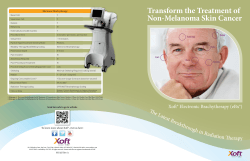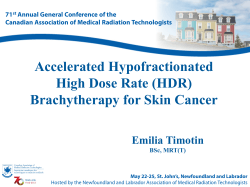
Prostate abscess: a rare complication of brachytherapy for prostate cancer
doi 10.1308/147870809X400985 On-line Case Report Prostate abscess: a rare complication of brachytherapy for prostate cancer PAUL E GILMORE, ANDREW D BAIRD, PRADIP M JAVLE Michael Heal Department of Urology, Leighton Hospital, Crewe, UK ABSTRACT Brachytherapy involves the therapeutic implantation of a radio-active seed source into, or close to, prostate cancer. We report the rare case of a 76-year-old man who presented with a prostate abscess after months of intractable pelvic pain following prostate cancer treatment with iodine125 brachytherapy. Despite multiple investigations, the diagnosis was made only once the abscess discharged exudate per-urethra. Keywords: Abscess – Brachytherapy – Prostate – Cancer Since the early 1980s, brachytherapy has become a valid alternative to both surgery and external beam radiotherapy in the treatment of localised prostate cancer.1 The present form of brachytherapy, otherwise known as interstitial therapy, has evolved since Pasteau and Degrais in Paris used radium to treat prostatic cancer in 1907.2 The use of iodine-125 permanent seeds is usually reserved for men with small prostates of less than 50-cm3 volume and with organ-confined, low-grade disease. Although there are men who suffer from prostatitis postimplantation, the majority of post-treatment symptoms settle by 3 months.3 Here, we describe the rare case of a prostate abscess developing in an otherwise healthy man following iodine-125 seed brachytherapy treatment for prostate adenocarcinoma. The only other documented case of prostate abscess developing after brachytherapy was reported in an HIV-positive man whose underlying pathology turned out to be squamous carcinoma of the prostate and rectum.4 Case report A 76-year-old man was referred to our urology department in Spring 2005 with a serum prostate specific antigen (PSA) level of 7.3 ng/ml. The man had pursued PSA screening after his brother had brachytherapy for prostate cancer in the US. Trans-rectal ultrasound and biopsies revealed a 38-cm3 gland containing Gleason 3+3 adenocarcinoma. Magnetic resonance (MR) imaging helped confirm stage T1c disease and he was deemed suitable for low-dose brachytherapy with permanent iodine-125 seed implantation. Postoperatively, he developed painful retention of urine requiring a urethral catheter to be placed. Over the following 6 months and despite medical treatment with an α1A blocker, nonsteroidal anti-inflammatories and a protracted course of quinolone antibiotics, he complained of chronic pelvic pain. During this period, his PSA dropped to 1.6 ng/ml, his inflammatory markers were not significantly raised Correspondence to: Paul E Gilmore, Specialist Registrar, Michael Heal Department of Urology, Leighton Hospital, Middlewich Road, Crewe CW1 4QJ, UK. E: pegilmore@tiscali.co.uk Ann R Coll Surg Engl 2009; 91 1 GILMORE BAIRD JAVLE Prostate abscess: a rare complication of brachytherapy for prostate cancer Figure 1 Post-brachytherapy changes in the prostate shown on a T1-weighted MR scan of the pelvis in horizontal (A) and coronal (B) cross sections. Small cavitations within the peripheral zone represent previous iodine-125 seed implantation (black arrow). The low attenuation areas on the right of the prostate represent inflammatory change (white arrows). and his catheter specimen of urine showed pyuria and bacterial colonisation only. MR imaging at 6 months delineated areas of prostatitis (Fig. 1). Rigid cystoscopy was normal and allowed placement of a suprapubic catheter. His symptoms appeared to have resolved when, at 7 months post-brachytherapy, he was admitted to our unit with a purulent exudate discharging via his urethra representing a ruptured prostatic abscess. Microbiological culture of this exudate confirmed Staphylococcus aureus as the causative organism and confirmed its sensitivity to flucloxacillin antibiotic treatment. Subsequent MR imaging during this admission, just 1 month following the aforementioned scan, revealed an abscess cavity affecting the prostate and extending into the adjacent levator muscles (Fig. 2). He was systemically well with no pyrexia or leukocytosis and a C-reactive protein level < 5mg/l. No further intervention was required and he successfully had his suprapubic catheter removed 4 weeks later. Conclusions Brachytherapy as a primary treatment for organ confined adenocarcinoma of the prostate is now well established in the UK. Although the long-term, disease-specific survival data of brachytherapy versus other prostate cancer treatments are not yet available, it does appear to be a valid alternative.5 The main side-effects of prostate brachytherapy are biochemical failure, urinary symptoms and erectile dysfunction. Proctitis, seed migration and rectovesical fistula occur far less frequently.6 The use of Figure 2 T1-weighted MR scan images taken within 24 h of the emergency presentation with purulent discharge per urethra. Views from the coronal (A) and horizontal (B) cross-sections show the abscess’s involvement of the adjacent levator muscles (white arrows). The suprapubic catheter can be seen entering the bladder (black arrow). 2 Ann R Coll Surg Engl 2009; 91 Prostate abscess: a rare complication of brachytherapy for prostate cancer transurethral resection of prostatic tissue is well recognised in the management of a prostatic abscess; however, in postbrachytherapy patients, it results in a high incidence of urinary incontinence.7 The presented case illustrates that a prostatic abscess is a rare cause of chronic pelvic pain following brachytherapy for prostate cancer. References 1. Holm HH, Juul N, Pedersen JF, Hansen H, Strøyer I. Transperineal 125-iodine seed implantation in prostatic cancer guided by transrectal ultrasonography. J Urol 2002; 167 : 985–8, discussion 988–9. 2. Pasteau O, Degrais P. De l’emploi du radium dans le traitement des cancers de la prostate. J Urol Med Chir 1913; 4: 341–66. Ann R Coll Surg Engl 2009; 91 GILMORE BAIRD JAVLE 3. Lee WR, McQuellon RP, Case LD, deGuzman AF, McCullough DL. Early quality of life assessment in men treated with permanent source interstitial brachytherapy for clinically localized prostate cancer. J Urol 1999; 162: 403–6. 4. Silberstein J, Downs T, Lakin C, Kane CJ. HIV and prostate cancer: a systematic review of the literature. Prostate Cancer Prostatic Dis 2008; 12: 6–12. 5. Blasko JC, Grimm PD, Sylvester JE, Badiozamani KR, Hoak D, Cavanagh W. Palladium-103 brachytherapy for prostate carcinoma. Int J Radiat Oncol Biol Phys 2000; 46: 839–50. 6. Merrick GS, Wallner KE, Butler WM. Permanent interstitial brachytherapy for the management of carcinoma of the prostate gland. J Urol 2003; 169: 1643–52. 7. Kollmeier MA, Stock RG, Cesaretti J, Stone NN. Urinary morbidity and incontinence following transurethral resection of the prostate after brachytherapy. J Urol 2005; 173: 808–12. 3
© Copyright 2025













